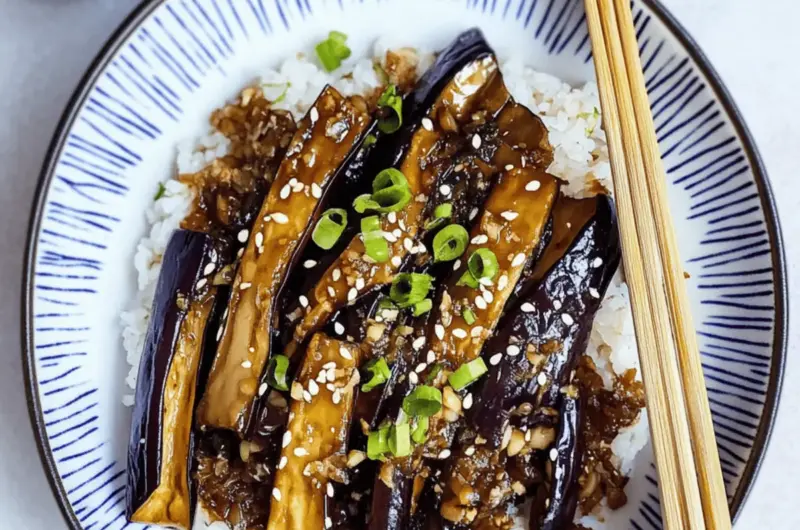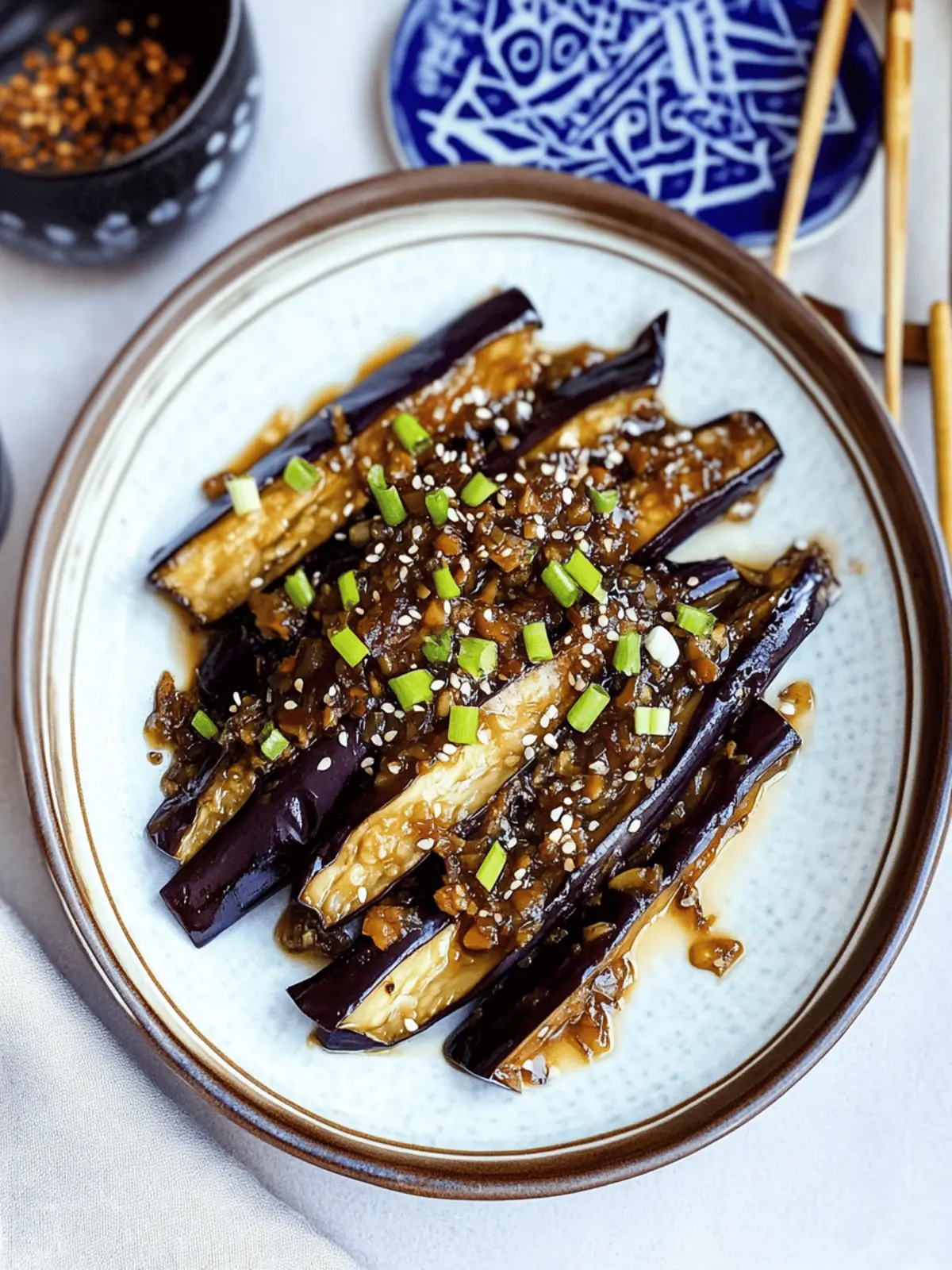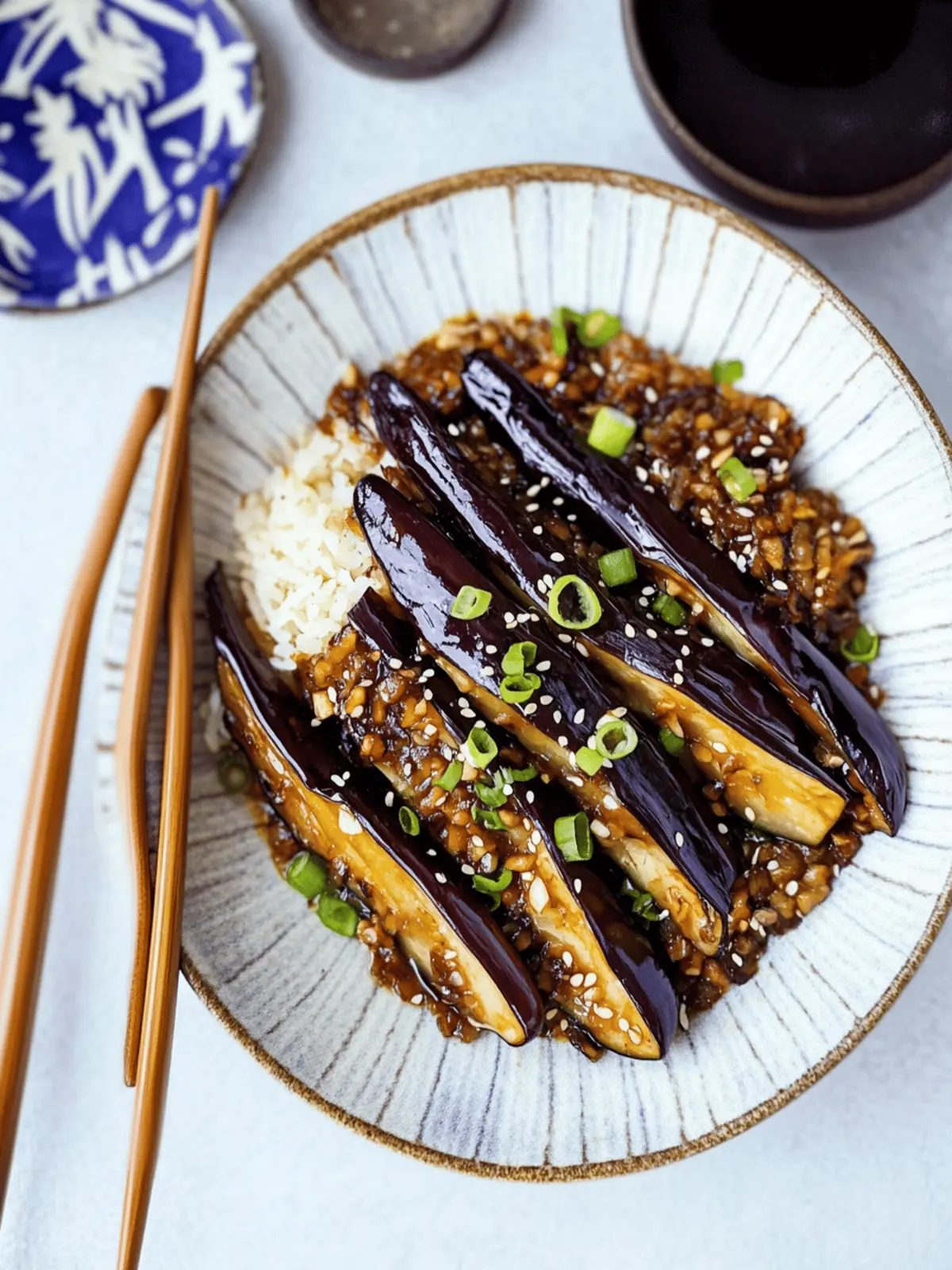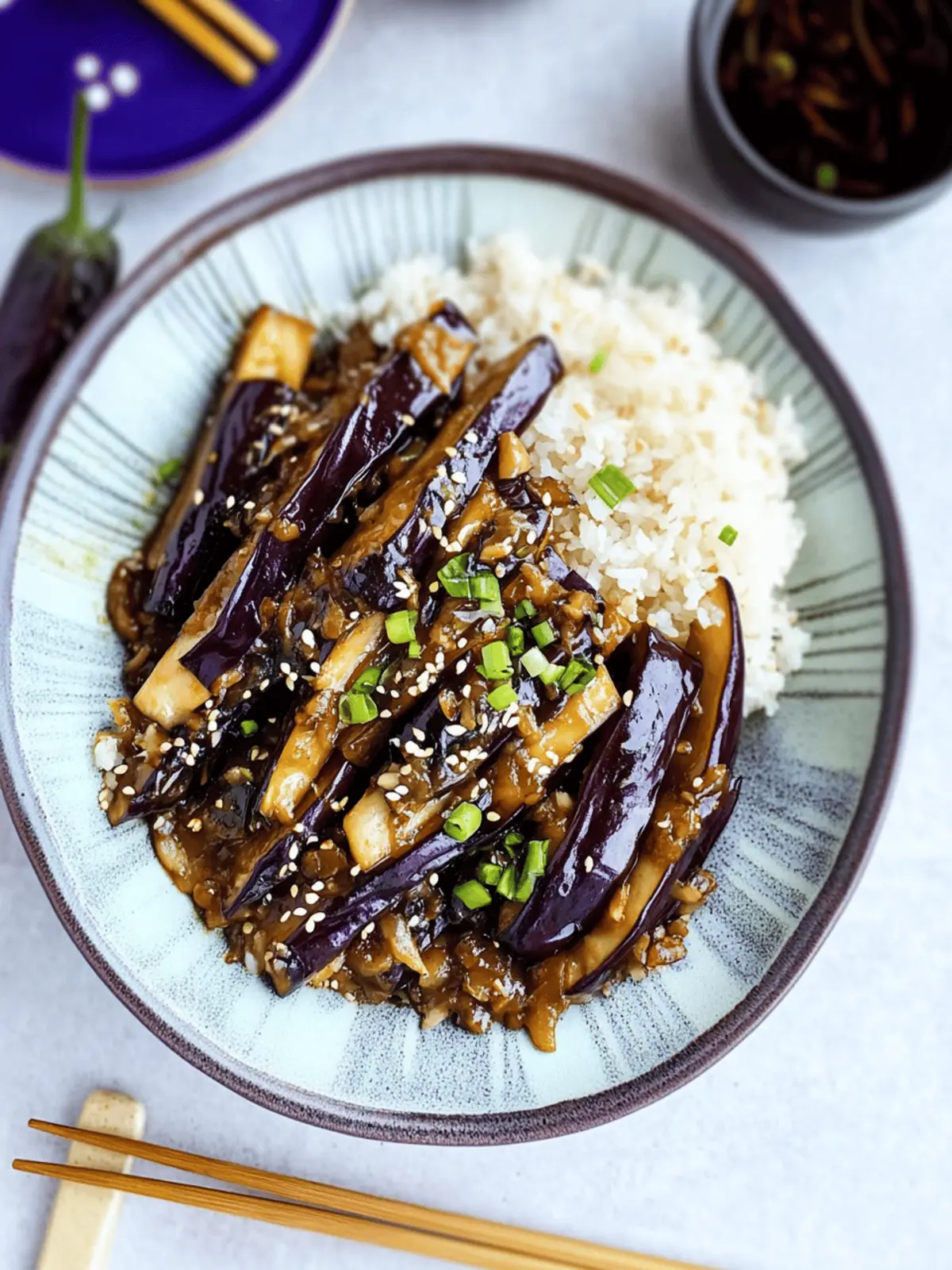Have you ever stumbled upon a dish that feels like a warm hug for your taste buds? That’s exactly how I felt the first time I sautéed Japanese eggplant. The vibrant purple skin and velvety texture seem downright luxurious, while the fragrant blend of ginger and scallions fills the kitchen with an irresistible aroma.
This recipe is perfect for those late evenings when you want something comforting yet quick to whip up. In just 25 minutes, you can transform simple ingredients into a savory delight that will impress anyone at your table. Whether you’re a seasoned chef or a home cook experimenting with new flavors, sautéed Japanese eggplant brings a unique twist to your dining experience, and I’d love to share the joy it has brought to my meals. So grab your skillet and let’s dive into this delicious adventure!
Why is Sauteed Japanese Eggplant a Must-Try?
Flavorful, this dish bursts with a savory blend of ginger and miso that elevates the humble eggplant. Quick to prepare, in just 25 minutes, you’ll have a scrumptious meal ready even on busy weeknights. Healthy and low in calories, it’s packed with nutrients that nourish your body. Versatile enough to serve as a side or a main dish, it pairs wonderfully with rice or noodles. Impressive for hosting, this vibrant dish will wow your guests and leave them craving more! Whether you’re looking to shake off fast food or explore fresh cuisine, this sautéed delight is your ticket to a flavorful feast!
Sauteed Japanese Eggplant Ingredients
• Dive into the world of flavor with these essential ingredients for a delightful meal!
For the Sauté
- Vegetable oil or grapeseed oil – Ideal for high-heat cooking, these oils won’t overpower the dish.
- Japanese eggplant – The star of the show, its tender flesh and skin enhance the flavor profile.
- Scallions – Add a fresh, mild onion flavor that complements the sauté beautifully.
- Shiitake mushrooms – Their rich umami taste makes this dish even more savory and satisfying.
- Fresh ginger – A zesty burst of flavor, ginger balances the dish with warmth.
For the Sauce
- Water – Helps to dissolve the miso paste for a smooth sauce consistency.
- White miso paste – This sweet and savory ingredient gives depth to the sautéed Japanese eggplant.
- Sesame oil – Adds a nutty aroma and finish that ties all the flavors together.
- Soy sauce – Provides a salty punch; feel free to use low-sodium if preferred.
- Salt and pepper – Essential seasonings that enhance the overall taste.
How to Make Sauteed Japanese Eggplant
-
Heat the Oil: In a skillet over medium heat, add 1 tablespoon of vegetable oil or grapeseed oil. Swirl it around to coat the entire surface, creating a non-stick base for your eggplant.
-
Cook the Eggplant: Place the three Japanese eggplants in the skillet and cook for 3 minutes. Flip them over and continue cooking for another 3 minutes, until they become tender and vibrant. Transfer to a cutting board to cool.
-
Mix the Sauce: In a bowl, mix 2 tablespoons of water, 1 teaspoon of white miso paste, 2 teaspoons of sesame oil, and 2 teaspoons of soy sauce. Season with salt and pepper, and set it aside to meld the flavors.
-
Slice the Eggplants: Using a sharp knife, slice each cooled eggplant into 4 lengthwise pieces. This allows them to absorb the sauce beautifully when added to the skillet.
-
Sauté the Aromatics: In the same skillet, heat it to medium-high and add the finely chopped scallions, shiitake mushrooms, and minced ginger. Sauté for about 3 minutes until the mushrooms are slightly caramelized and fragrant.
-
Combine and Stir-Fry: Add the sliced eggplants back into the skillet along with the prepared sauce. Stir-fry for approximately 1 minute, or until the eggplant is warmed through and coated with the delicious sauce. Transfer everything to a plate and serve immediately.
Optional: Garnish with sesame seeds for an added crunch.
Exact quantities are listed in the recipe card below.
Make Ahead Options
These Sauteed Japanese Eggplant are a fantastic choice for meal prep, allowing you to save time during busy weeknights! You can prepare the eggplants by cooking and slicing them up to 24 hours in advance. Simply cool them to room temperature, then store them in an airtight container in the refrigerator. Additionally, mix the sauce ingredients (water, miso paste, sesame oil, and soy sauce) and keep it refrigerated for up to 3 days. When you’re ready to serve, quickly sauté the scallions, shiitake mushrooms, and ginger in the skillet, then add your prepped eggplant and sauce, and stir-fry for just a minute until warmed through. This way, you’ll enjoy restaurant-quality results in no time!
What to Serve with Sauteed Japanese Eggplant?
Elevate your dining experience with delightful pairings that complement the savory notes of this eggplant dish.
-
Steamed Jasmine Rice: Its subtle sweetness and fluffy texture provide a perfect base that soaks up the delicious sauce.
-
Garlicky Snow Peas: These crisp veggies offer a contrasting crunch and bright flavor, enhancing the meal’s freshness.
-
Quick Pickled Cucumbers: Their tangy zing adds a refreshing bite, balancing the rich umami flavors of the sautéed eggplant.
-
Sesame Spinach Salad: This nutritious side, with its nutty dressing, complements the dish and adds a vibrant pop of color.
-
Teriyaki Chicken: A sweet and savory option that pairs harmoniously with the earthiness of the eggplant for a more robust meal.
-
Sake or Green Tea: Enjoy a glass of chilled sake to up the Japanese vibe or serve with a warm cup of green tea to cleanse your palate.
How to Store and Freeze Sauteed Japanese Eggplant
-
Fridge: Store leftovers in an airtight container for up to 3 days. Reheat in a skillet over medium heat, adding a splash of water to maintain moisture.
-
Freezer: For longer storage, freeze the sautéed Japanese eggplant in a freezer-safe bag for up to 2 months. Thaw in the fridge overnight before reheating.
-
Reheating: Gently reheat on the stovetop or in the microwave until warmed through. You can add a little sesame oil to freshen up the flavors.
-
Avoiding Sogginess: To retain the eggplant’s texture, avoid reheating in the microwave for too long, as it may become mushy.
Sauteed Japanese Eggplant Variations
Feel free to put your own spin on this delectable dish and make it uniquely yours!
-
Vegan: Omit the miso paste or replace it with a chickpea miso for a similar umami flavor that’s entirely plant-based.
-
Spicy Kick: Add some red pepper flakes or minced fresh chili to the sauce for a delightful heat that will tantalize your taste buds.
-
Mushroom Medley: Swap out shiitake mushrooms for other varieties like oyster or portobello for different textures and flavors that still shine through.
-
Crunchy Toppings: Top with crushed peanuts or toasted cashews for an exciting crunch that contrasts beautifully with the soft eggplant.
-
Herbaceous Twist: Stir in fresh herbs like basil or mint right before serving to give a vibrant, fresh finish that brightens the dish.
-
Coconut Milk Surprise: Replace half of the water in the sauce with coconut milk for a creamy yet exotic flavor that adds a touch of sweetness.
-
Savory Miso Variations: Experiment with different miso types, such as red or beige miso, to create a new flavor profile that brings warmth and depth.
-
Citrusy Zing: Squeeze some fresh lime or lemon juice over the sautéed eggplant just before serving for an invigorating brightness that cuts through the richness.
Expert Tips for Sauteed Japanese Eggplant
-
Choose Fresh Eggplant: Select firm, shiny Japanese eggplants for the best texture and flavor. Avoid any with brown spots or soft spots.
-
Slice Evenly: When cutting your eggplants, ensure uniform slices. This promotes even cooking and allows the sauce to coat each piece beautifully.
-
Watch the Heat: Sauté on medium heat to avoid burning the garlic and ginger, which can turn bitter. A gentle sizzle is all you need for the perfect sautéed Japanese eggplant.
-
Taste as You Go: Adjust the seasoning to your liking, adding a pinch of salt or a dash more soy sauce if needed. This helps to enhance the overall flavor.
-
Garnish for Flair: Consider adding toasted sesame seeds or fresh herbs like cilantro on top before serving. It elevates the dish visually and adds layers of flavor.
Sauteed Japanese Eggplant Recipe FAQs
What should I look for when choosing Japanese eggplant?
Absolutely! When selecting Japanese eggplant, choose firm and glossy specimens without any brown or soft spots. The skin should be vibrant and smooth, indicating freshness. You can also pick ones that are slightly smaller, as they tend to be sweeter and less bitter.
How should I store leftover sauteed Japanese eggplant?
After enjoying your sautéed Japanese eggplant, store any leftovers in an airtight container in the fridge for up to 3 days. It’s best to reheat it gently in a skillet over medium heat, adding a splash of water to avoid dryness. Always check the aroma and texture before serving!
Can I freeze sauteed Japanese eggplant?
Yes! To freeze your sautéed Japanese eggplant, allow it to cool completely, then transfer it to a freezer-safe bag. Flatten the bag for better storage and freeze for up to 2 months. When ready to enjoy, simply thaw it in the fridge overnight and reheat gently on the stovetop.
What can I do if my eggplant turns out mushy?
Very! If your sautéed Japanese eggplant turns out mushy, it’s likely due to overcooking or using overly ripe eggplants. To avoid this next time, be sure to select firm eggplants and keep an eye on cooking times. If you find yourself in this situation, try adding a splash of soy sauce and handful of fresh herbs to brighten the dish—this will enhance flavors and help resurrect its charm!
Is sauteed Japanese eggplant suitable for vegetarians or vegans?
Absolutely! The sautéed Japanese eggplant is not only delicious but is also completely vegetarian and vegan-friendly. It’s a wholesome dish made purely with plant-based ingredients, making it perfect for everyone, including those avoiding animal products. Just ensure that your soy sauce is vegan, as some brands might have added preservatives.
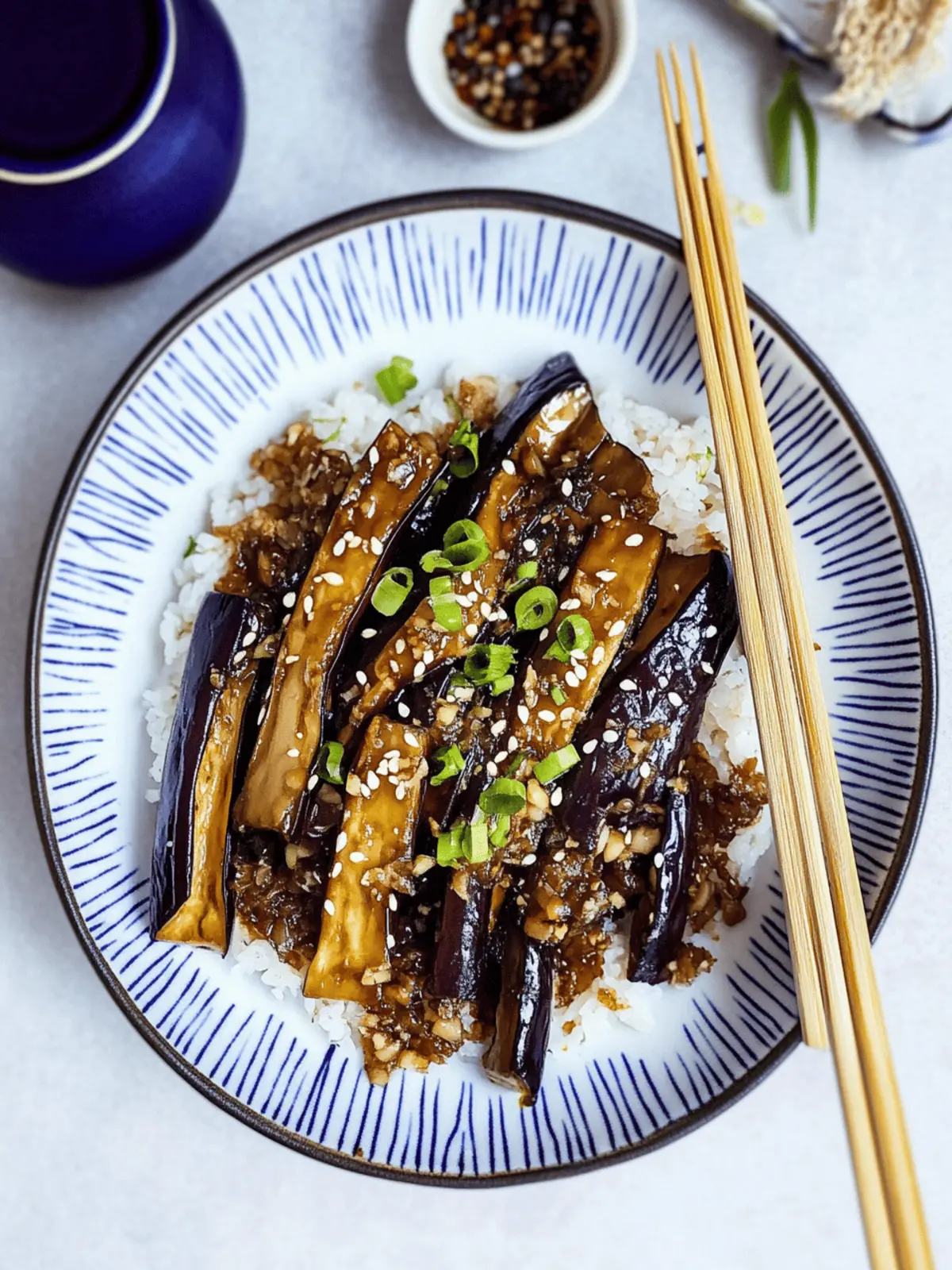
Savory Sauteed Japanese Eggplant for a Flavorful Feast
Ingredients
Equipment
Method
- In a skillet over medium heat, add vegetable oil or grapeseed oil and coat the surface.
- Place the Japanese eggplants in the skillet and cook for 3 minutes. Flip and continue for another 3 minutes until tender.
- In a bowl, mix water, white miso paste, sesame oil, and soy sauce. Season with salt and pepper.
- Slice each cooled eggplant into 4 lengthwise pieces.
- In the same skillet, heat to medium-high and add chopped scallions, shiitake mushrooms, and minced ginger. Sauté for 3 minutes.
- Add sliced eggplants and sauce to the skillet, stir-fry for 1 minute until warmed through.

